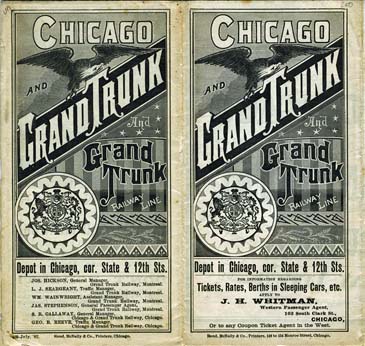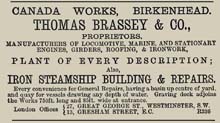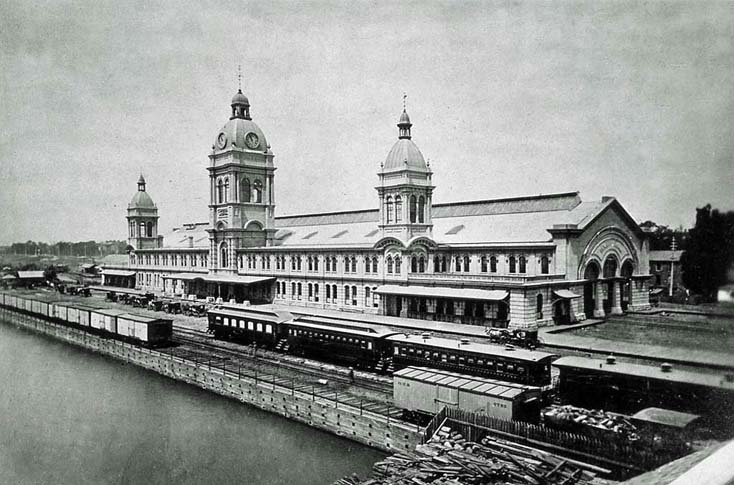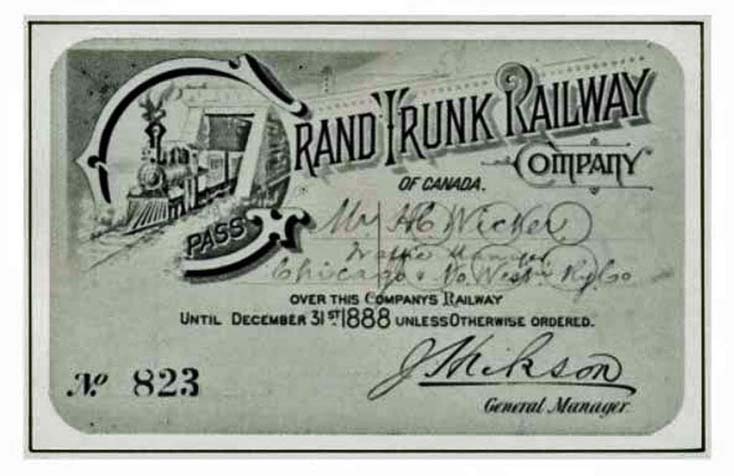Archive
Introduction
Canals
Britain
Trunk Line
Gauge
Construction
Steel
Labour
Competition
Hays
Titanic
Credits
Background
When the Grand Trunk was projected in 1852, it was to be the longest railway in the world. Later, it was characterized as the world's worst commercial failure. It was, in fact, a pioneer, in design and management, in finance, and in the economic interrelations of Britain, the United States, and Canada. It was a pioneer, too, in that it gave Canadians one of the earliest experiences with "big business" - A.W. Currie "The Grand Trunk Railway of Canada".
This succinct analysis, by the author of what is unquestionably the best business history of the GTR yet written, sums up the seven-decade career of one of Canada's most interesting railway companies. Organized in 1853, and largely financed by Great Britain, its operations were dominated for more than 40 years by and absentee directorate in London which appointed Britons to manage operations in Canada. With the hiring of the American Charles M. Hays as general manager in 1896 the GTR's organization and operating practices underwent profound changes, and for the firs time it became profitable. Hays died in the Titanic disaster of 1912, and while his policies were continued, the GTR was soon hopelessly bankrupt. Its corporate demise came in 1923 when it was absorbed into the five-year-old Canadian National Railways. The name persisted, however, in northern New England, which shared with Quebec the system's genesis. And just recently, in conjunction with developments in Michigan. But that's getting too far ahead. The overview properly begins with a look at events in the colonial provinces in the first half of the 19th century.
Compared with other industrialized countries, in Canada the railway era arrived late. Its earliest public railways, the first dating from 1836, were merely portage lines, minor components of a water transportation system based upon the St. Lawrence River, its navigable tributaries, and the Great Lakes, a system which reached practically to the center of the North American continent. The steamboat had made its debut in Canada in 1809, only two years after Robert Fulton's "Clermont" began plying the Hudson. There followed a rapid development of this new form of water transportation. Then, the opening of the Erie Canal across New York State in 1825 stimulated similar projects in the St. Lawrence Basin, undertaken as public works by the colonial governments of Upper and Lower Canada. By the 1840s the public debt for canals was so large (about $100 per capita) that the investment of additional funds to build railways in the sparsely settled colonial provinces was simply out of the question. The Development of a comprehensive railway system had to wait until after mid-century.
When that development came, it was largely financed in the United Kingdom. The principal railways were directed by boards situated on the other side of the Atlantic, with local management entrusted to British-trained executives. These men were unfamiliar with the engineering and operational exigencies of the North American climate and geography, and also with the more democratic and egalitarian political milieu. Financial arrangements were often entrusted to contracting firms, which were themselves British. Lack of confidence in railway stocks, a legacy of the collapse of the British "Railway Mania" of the 1840s, rendered sales contingent upon heavy discounts. This, combined with the necessity of rebuilding or replacing British-style track, motive power, and rolling stock within a very few years, resulted in the over capitalization which dogged the Grand Trunk for most of its life.
Contributing to the financial distress of all early Canadian railways was the country's small population compared to that of the neighboring United States. Traffic never measured up to the optimistic forecasts of promoters. Moreover, since the first trunk railways paralleled navigable waterways, they could not readily compete against marine transportation, either with respect to rates or to capacity, during the eight month season of ice-free navigation.
It is with this rather inauspicious background in mind that we must now consider the proposals that emerged in 1849 for a "main line" or "trunk railway" uniting the British North America provinces, proposals subsequently embodied in the Main Trunk Line of Railway Act of 1851. While Nova Scotia and New Brunswick wrestled with plans in their territory, the Province of Canada proceeded with the creation of the "trunk" between its eastern and western limits, the first step being the inception in 1852 under the Province of Canada Act, 16 Victoria, Chapter 37, to build a railway from Toronto to Montreal. This act was given royal assent on November 10, and the initial meeting and election of a board took place on 11 July 1853. Under an agreement of 12 April 1853 (effective 1 July and assented to on 18 December 1854), the new GTR was amalgamated with five other companies. Four of these were "paper" organizations, but the fifth, the St. Lawrence & Atlantic Rail Road Company (incorporated in 1845) had just completed a line between Longueil, Quebec (opposite Montreal), and the International Boundary near Stanhope. There it connected with the Atlantic & St. Lawrence Rail Road, which had been incorporated in Maine in 1845, in New Hampshire in 1847, and in Vermont in 1848, to build a railway from Portland to the Canadian border. Service between Montreal and Portland, 292 miles, was inaugurated on 18 July 1853. Since the Grand Trunk was not incorporated in the USA, an agreement dated 1 August provided for a 999 year lease of the A&StL.
(Builder of the A&StL was John A. Poor, older brother of Henry Varnum Poor, who attained fame as editor of the American Railroad Journal and later publisher of the Manual of Railroads of the United States. The story of the A&StL is highlighted by John Poor's dramatic dash from Portland to Montreal in a fierce blizzard to win the Montreal Board of Trade's final assent to a Portland outlet rather than Boston.)
The intent of the Montreal-Portland railway was to give Montreal access to a year-round ocean port. Construction had been fostered by Montreal mercantile interests, acting in concert with entrepreneurs in Portland who sought for that city the status and prosperity enjoyed by such port cities as Boston, New York, and Baltimore.
To ensure that Canadian traffic would flow to Portland, and not elsewhere, the StL&A/A&StL had been built to a gauge of 66 inches (5 feet 6 inches), or broad gauge, a gauge not then used anywhere in the US.
(There are a number of broad gauges throughout the world. Russian gauge is 5 feet wide, includes the former Soviet Union, CIS states, Baltic states, Georgia, Ukraine, Mongolia, and Finland. Irish gauge of 5 feet 3 inches in Ireland and Victoria, Australia. Iberian gauge of 5 feet 5 21/32 inches in Spain and Portugal. Indian gauge of 5 feet 6 inches is found in India, Pakistan, Bangladesh, Sri Lanka, Argentina, Chile, and on the Bay Area Rapid Transit in San Francisco. In England, Brunel's Great Western Railway gauge of 7 feet was later increased to 7 feet and 1/4 inch before being abandoned for today's standard gauge of 4 feet 8 1/2 inches.)
On 31 July 1851, this gauge was enshrined into Canadian law when the Railway Committee of the Provincial Parliament made its adoption a precondition for receiving government financial aid under the Guaranty Act of 1849. As a result, the vast majority of all railway mileage built in British North America during the ensuing two decades was laid to the so-called "provincial gauge".
When the GTR turned to the task of constructing its "trunk" between Montreal and Toronto, it commenced by awarding several contracts to the British firm of Peto, Brassey, Betts & Jackson, which in turn helped to raise funds in the United Kingdom with the aid of Glyn, Mills, & Company, and Baring Brothers & Company, two renowned London banking firms. In addition to the track building contract, the Peto firm also contracted to build the Victoria Tubular Bridge at Montreal, a structure which, when completed several years later, was considered one of the wonders of the engineering world. To provide the Grand Trunk with motive power and rolling stock, Peto built its own manufacturing plant, known as the "Canada Works", at Birkenhead, hear Liverpool. The Canada Works adapted the Allan "Crewe Goods" locomotive design of the London & North Western Railway (whose trackage served the plant) for the Grand Trunk's initial engines. Later, several were constructed for the Great Western Railway of Canada as well. "Birkenheads", as they were known to employees, comprised Canada's first distinctive engines.
All too soon, the GTR was to feel the effects of the financial crisis of 1857. Before that, however, it completed a branch from Richmond, Quebec, to Levis, opposite Quebec City (1854), and also the trunk between Montreal and Toronto (October 1856). By the end of 1859 that line had been extended to Sarnia, Ontario, where a ferry connected with Port Huron, Michigan, and the standard gauge Chicago, Detroit, & Canada Grand Trunk Junction Railway Company, operator of a 60 mile line to Detroit which was leased by the GTR in 1860. Likewise in 1860, the Victoria Bridge was officially opened and trackage extended from Levis to Riviere-du-Loup on the lower St. Lawrence, under the charter of the Grand Trunk Railway of Canada East (dated 10 November 1852). This resulted in an 800 mile main line, at the time the longest railway in the world under one management.
was officially opened and trackage extended from Levis to Riviere-du-Loup on the lower St. Lawrence, under the charter of the Grand Trunk Railway of Canada East (dated 10 November 1852). This resulted in an 800 mile main line, at the time the longest railway in the world under one management.
That was some distinction, to be sure, though the railway's general fortunes during this period were nothing if not mixed. The adoption of British modes of construction, ill-suited to the climatic conditions prevalent in Canada, precipitated a great deal of trouble with the track. Inverted U-section rails, joined together in track chairs, proved inferior to the standard T-rail and fishplate construction of North America, and rails had to be renewed completely after a short time. These financial demands added to the burdens resulting from the mode of financing in Great Britain. In addition, rigid-framed locomotives had to be rebuilt, and four-wheeled freight cars replaced with double-truckers to minimize loading on the iron rails. Indeed, some cars had six and eight-wheeled trucks, though the GTR still used British style four-wheeled brake vans as late as the mid-1860s. And only in 1870, when Parliament repealed the provincial gauge legislation, did the company begin in earnest to replace iron rails with steel.
In 1864 the Grand Trunk leased the Montreal & Champlain Rail Road, a standard gauge system based in Montreal with two routes extending into New York State, one to Rouses Point, the other to Plattsburgh. The M&C included Canada's first railway, the Champlain & St. Lawrence, opened in 1836. likewise, in 1864 the GTR leased the Buffalo & Lake Huron Railway, extending 161 miles from Fort Erie to Goderich, Ontario, thereby entering into direct competition with the Great Western Railway. The other major event of 1864 was Canada's worst railway disaster . On 28 June 1864, 99 died when an immigrant train behind GTR engine number 128, "Ham", plunged through an open drawbridge at Beloeil, Quebec. Ham had been built in 1857, the first engine outshopped by Gunn in Hamilton, and the accident was caused by the inability of the locomotive and train crew to come to a stop in time. In the aftermath, attention focused on such fundamentals as the formal training of operating employees, the employment of full crews, and the inadequacy of British style marker lamps compared to American style headlights.
. On 28 June 1864, 99 died when an immigrant train behind GTR engine number 128, "Ham", plunged through an open drawbridge at Beloeil, Quebec. Ham had been built in 1857, the first engine outshopped by Gunn in Hamilton, and the accident was caused by the inability of the locomotive and train crew to come to a stop in time. In the aftermath, attention focused on such fundamentals as the formal training of operating employees, the employment of full crews, and the inadequacy of British style marker lamps compared to American style headlights.
In the prosperous period between confederation of the Dominion of Canada on 1 July 1867 (initially comprising the present-day provinces of Ontario, Quebec, New Brunswick, and Nova Scotia) and the depression of the mid-1870s, the GTR carried through several significant projects. The International Bridge between Fort Erie and Buffalo was begun in 1870 and opened in 1873. Emulating the Great Western, its competitor in southwestern Ontario, the GTR also began to standard gauge. Lines converging on Stratford were converted in November 1872, the main line between Stratford and Montreal in October 1873, and the remaining lines east of Montreal in September 1874. Attendant alterations to rolling stock were relatively simple, but the conversion of locomotives was not, the majority of those built in the 1850s were retired. While only 163 broad gauge engines were re-gauged with narrower fireboxes and frames, among these were most of the remarkably durable Birkenheads. At about this same time, wood was becoming too expensive to use as fuel and the GTR began turning to coal, though not until peat, gathered in Quebec's Eastern Townships, had been tried experimentally around Montreal.
The GTR first contracted with the Pullman Company for sleeping car service on 1 July 1870. In 1871 new locomotive shops were built at Stratford and a new car shop at Brantford. And in May 1872 work was begun on a new station at Toronto designed to accommodate all the major railways serving that city and supplant smaller individual terminals. Though the previous GTR station had also served the Great Western and the Northern between May 1858 and March 1866, this was Toronto's first true Union Station. Surmounted by impressive clock towers, it opened on 1 July 1873.
As for its salaried employees, effective 1 October 1874, the GTR established a Superannuation and Provident Fund, sometimes said to be the first formal pension plan in North America. The onset of depression in 1873 temporarily halted railway expansion, though it was obliquely beneficial to the GTR in that it arrested construction of would-be competitors. For a few days around New Year's of 1877, a strike of locomotive enginemen disrupted operations, presaging similar troubles in the US later in the year.
Though 1877 was one of the most turbulent years n railway labour history, it also marked the beginnings of recovery from the depression. It was in 1877 that the GTR began taking steps to acquire additional lines in Michigan, the aim being to establish its own route through Chicago. Having raised some of the necessary funds by selling its line from Levis to Riviere-du-Loup to the Intercolonial Railway in 1879, the GTR made it Windy City connection in 1880, the first trains operating on 8 February 1880.
Soon, however, management had to turn its attention back to home territory. For it was in 1881 that a major rival appeared on the scene, a competitor seeking to build up its own network in eastern Canada, the Canadian Pacific Railway. The Grand Trunk's response was to embark upon an ambitious and costly program of acquiring major lines in Ontario and Quebec. On 12 August 1882, it amalgamated with an old competitor, the Great Western Railway. In addition to lines in Ontario, this acquisition included the Detroit Grand Haven & Milwaukee Railroad, a 189 mile line from Detroit to Grand Haven, Michigan. In December 1882 the GTR acquired control of the North Shore Railway Company from Montreal to Quebec, but subsequently, in September 1885, the government forced relinquishment to the CPR. More durable was the lease of the Midland Railway, a network north and east of Toronto, effective 1 January 1884. Later in 1884 the GTR gained control of the Central Vermont, and on 24 February 1888, it amalgamated with the Northern & North Western (combined Hamilton & North Western Railway and Northern Railway of Canada), whose lines extended into Ontario's Bruce Peninsula.
The GTR began to double-track its Toronto-Montreal main line in 1887 (a project completed in 1903), and in 1888 it built Bonaventure Station , a commodious passenger terminal at Montreal which was to remain in daily use for 60 years. Other line improvements of this period included the St. Clair River Tunnel
, a commodious passenger terminal at Montreal which was to remain in daily use for 60 years. Other line improvements of this period included the St. Clair River Tunnel , from Sarnia to Port Huron, which superseded car ferry service in 1891. On 24 September 1897, the GTR opened a new steel arch bridge
, from Sarnia to Port Huron, which superseded car ferry service in 1891. On 24 September 1897, the GTR opened a new steel arch bridge at Niagara Falls, replacing the Great Western's original road and rail suspension bridge built by John Roebling and dating from 1855.
at Niagara Falls, replacing the Great Western's original road and rail suspension bridge built by John Roebling and dating from 1855.
The latter development was subsequent to the arrival of the most significant figure in the Grand Trunk's history, Charles Melville Hays , who had been hired as general manager on 1 January 1896. Hays introduced drastic changes in organization and operating practice, changes which had the effect of completing the GTR's conversion from a colonial railway to an American system. Early in 1898 the Grand Trunk signed an agreement with Wabash (whence Hays had come) giving the latter joint use of the GTR line between Windsor, Ontario, and Black Rock, New York (via Glencoe and St. Thomas), as well as the line from Welland Junction to Suspension Bridge, New York, and across the Niagara River. Hays left in 1900 to accept a position with the Southern Pacific Company, but returned to the Grand Trunk in 1902. During the next few years many smaller lines were absorbed, as well as one major system, the Canada Atlantic Railway, whose lines, reaching from Georgian Bay to Alburgh, Vermont, the GTR took over on 1 October 1905.
, who had been hired as general manager on 1 January 1896. Hays introduced drastic changes in organization and operating practice, changes which had the effect of completing the GTR's conversion from a colonial railway to an American system. Early in 1898 the Grand Trunk signed an agreement with Wabash (whence Hays had come) giving the latter joint use of the GTR line between Windsor, Ontario, and Black Rock, New York (via Glencoe and St. Thomas), as well as the line from Welland Junction to Suspension Bridge, New York, and across the Niagara River. Hays left in 1900 to accept a position with the Southern Pacific Company, but returned to the Grand Trunk in 1902. During the next few years many smaller lines were absorbed, as well as one major system, the Canada Atlantic Railway, whose lines, reaching from Georgian Bay to Alburgh, Vermont, the GTR took over on 1 October 1905.
Hays became the Grand Trunk's president in 1910, but was dead only two yeas later, a victim of the Titanic disaster of 15 April 1912. From that point on the road's problems began to multiply daily. Increased costs of labour and materials brought on by the World War compounded the burden of financial obligations incurred in completing the Grand Trunk Pacific. Bankruptcy followed in short order, in 1916. In May 1917 the government appointed Drayton-Acworth Commission submitted a majority report recommending government acquisition of the Grand Trunk, the Grand Trunk Pacific, and the Canadian Northern, and operation along with the existing Canadian Government Railways, the former Intercolonial, as a unified system in the public interest.
(A minority report proposed that instead of nationalization the government ought to continue extending aid to the three privately-owned railways until they could reattain solvency.)
The GTP was taken off the Grand Trunk Railway's hands on 10 March 1919. After prolonged negotiations between the government and the GTR's shareholders and debenture holders, an arbitration board ruled that Grand Trunk stock had no value, and a government order-in-council dated 19 January 1923, vested the whole of the property in the government of Canada. The property was in turn entrusted to the Canadian Government Railways' successor, the Canadian National. It was the end of an era, though, as we shall see, far from an absolute demise.
Omer Lavallée - Railroad History No. 147 (Autumn 1982), pp. 12-18 Railway & Locomotive Historical Society (R&LHS)
- Railroad History No. 147 (Autumn 1982), pp. 12-18 Railway & Locomotive Historical Society (R&LHS)
Map of the Grand Trunk Railway and its connections - Date? Cartographer? - National Railway Publications.










